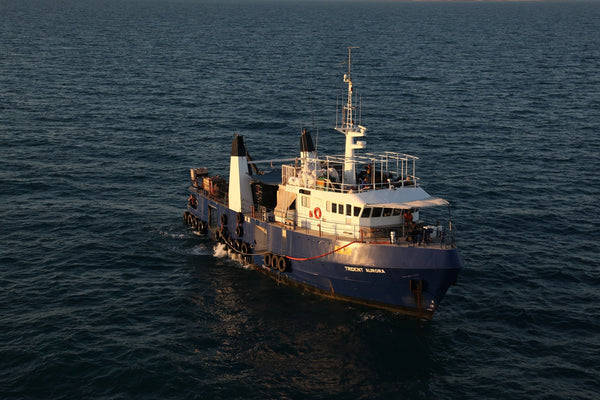 A Day in the Life
A Day in the Life
My experience on a South Sea pearl farm in Australia
By Ahbra Perry of 'On the Reel Productions.'
The iPhone alarm rings faintly; even Siri is still half asleep. There is rustling in the hallway. Someone must be as confused as I am. Hunched awkwardly in my cubbyhole of a bed, I pull open the porthole curtain to reveal dense blackness. I begin to worry. Maybe the ship began taking on water as I slept and we are now rapidly sinking, plunging deep below the surface of the ocean to a certain death, or worse- it’s really still that dark outside. I grab my toothbrush, fall out of my person-pantry (ladders are of little use at this time of the morning) and stumble into the hallway.
I make my way up to the deck like a drunken pinball, banging into the opposite side of the wall with every step. I throw my body against a heavy door and tumble onto the main deck where the harsh cold of sea air quickly gnaws at my core. My earlier fears are quickly realized. It’s 4:30 in the morning, totally dark outside (the sun isn’t even thinking about coming up for at least another hour), and everyone is already working.
Pearl farm life is strenuous, but for those who toil forward, rising at ungodly hours, it can be some of the most inspiring and rewarding work one can do. As on any farm, there is the constant challenge of creating and maintaining a delicate balance with Mother Nature. The pearl farmer is unavoidably at her mercy.
Each farm that I have visited in the past three years has shown me an occupation that is rich in adventure, and in beauty.
The requirements for a perfect site place these farms in pristine and picturesque environments in some of the most remote reaches of the world. Success in these regions relies heavily on the support of the communities built and sustained by these farms and is uniquely shaped by the indigenous cultures of the area.
Saltwater pearl farming has the potential to create positive impact on all fronts- we would be hard-pressed to find another industry to say the same for.
My film crew’s brief time documenting the life aboard the ships of an Australian South Sea pearl farm provided an experience marked by escapades that only pearl farming could offer.
The Trident Aurora serves as the command center for the Clipper Pearl Farm, and raises her anchor around 4 am. The divers will hit the water at first light, so all equipment must be prepared, tested, and properly functioning before dawn. Mistakes are not an option sixty feet below sea level.
Clipper Pearl’s and Autore’s mothership the Trident Aurora
Immediately after the dive boats are dispatched, preparation for their return is allegedly to begin. In reality, all deck hands immediately gather around the “WC” - not a toilet, but instead a closet containing instant coffee, Milo (a vitamin-enriched chocolate powder), and hot water. Everyone drags on rollies - hand rolled cigarettes, the bulk of whose tobacco tends to be taken by the wind. If the United Nations had a locker room, the chatter would sound something like these deckhands. The majority of them are young backpackers. Traveling the world, they are likely in need of a paycheck to afford their next destination. Greeks, Brits, a Scott, a Norwegian, Germans, Spaniards, French, and of course those from Australia and neighboring New Zealand all confer over a cup of coffee (and quite literally- I’m pretty sure there is really only one mug for ten people). Being in such tight quarters, they will get close quickly. Some have already been on a few trips out to sea together, while the rest are “real fresh for the season,” as one of the Kiwis tells me.
To be continued on September 9th ...






